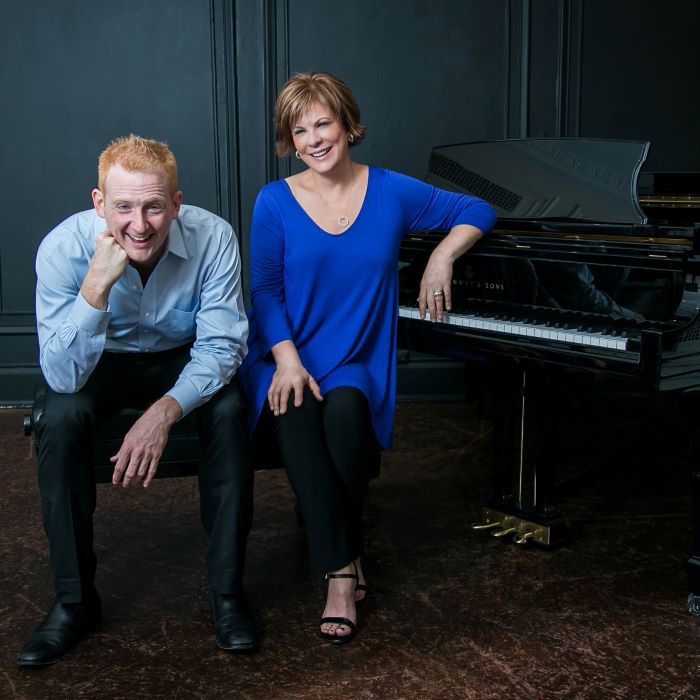Quattro Mani (Steven Beck & Susan Grace, pianos)
John ADAMS: Hallelujah Junction (1998)
Paul CRESTON: Rumba-Tarantella (1964)
Paul BOWLES: Night Waltz (1949)
Paul MORAVEC: Quattro Mani (2017)
Bent SØRENSEN: Six Intermezzi (2018)
Bridge Records, Inc. – BRIDGE 9552
Release Date: June 2, 2023
Format: CD & digital download
Duration: 47:36
By Giorgio Koukl | 5 JUL 2023
Among existing chamber music formations, the piano duo represents a bit of an aristocratic exception.
First of all, it is technically very challenging, with its request based on maximum rhythmical precision and no great means to express the dynamic, agogical, and sound variety when paralleled to, let us say, a string quartet. Second: it also has some logistical problems. When confronted with the capacities of a “normal” concert venue, the need for two concert pianos of the greatest quality is nearly impossible to obtain outside the top venues in the world.
Despite this, in the history of music since Bach, Mozart, and all the subsequent composers, practically everybody got fascinated by this kind of music, writing masterpieces.
It is justifiable to mention the first known stable piano duos: Vronsky and Babin, Gold and Fitzdale, Güher and Süher Pekinel, and the Labeque sisters, to mention only a few of the past.
This piano duo Quattro Mani, in its now nearly decade-old stable formation (pianists Steven Beck and Susan Grace) is stepping in a tradition not at all easy to follow. But let us say it right from the beginning: their incredible array of capacities is strong enough to place them precisely on the top of the piano duos of today. Certainly, they deserve to be heard with great attention, even playing the music of sometimes not-so-terribly great composers.
This Bridge Records installment puts together works of some living composers together with some lesser-known names of the past, generally staying in the 20th-century perspective even if with no visible liaison between the choices made.
We start with a lengthy work by John Adams (1947-) called Hallelujah Junction (1998).
The basic idea is a minimalist repetition of a rhythmical cell repeating, at least in theory, the word “Hal–le–LU–jah.” The highly evocative liner notes mention that this work should have three movements. Well, both facts are quite indistinguishable for the listener. Instead, a flow of repeated formulae, slightly changing over time, captures the interest. Even with its 17-minute duration, this is never dull or visibly artificial. Well worth mentioning is the tremendously difficult piano writing, requesting a precision rarely surpassed in the modern literature for two pianos. Here Quattro Mani literally shines. This music will probably never be a public pleaser, but in this rendering, it is well worth every minute dedicated to it.
A piece by Paul Creston (1906-1985) called Rumba-Tarantella follows. While certainly pleasant to listen to, this composer’s music is unfortunately placed in the middle of otherwise highly qualitative scores. Beck and Grace nevertheless play it with great “verve” and commitment.
Some historically difficult-to-place music of Paul Bowles (1910-1999) follows. As were so many other pieces, his Night Waltz was written for the forecited piano duo Gold and Fitzdale. This duo, active in New York during many decades during and after the Second World War, was a catalyst for many living composers; let us cite Vittorio Rieti, among many others.
Having lived in Morocco (and precisely in Tangiers) most of his life, Bowles was a natural attraction point for the new generations of European and American poets, writers, and composers, all of them in search of an alternative way to live a free life, quite different from the existing morale and values of their time. Strangely enough, there is no trace of any exoticism in this score and no visible rupture with the past in musical terms.
The piece called Quattro Mani, written for the Beck and Grace piano duo by Paul Moravec (1957-), is the highlight of this CD. It is a genuine gemstone, difficult beyond any imagination for the pianists and superbly played by them with breathtaking velocity and finesse.
The last work, Six Intermezzi, is written by the only non-US composer in this installment: Bent Sørensen (1958-). Some of the movements involve a strange, harpsichord-like sound which doubles the piano sound. Unluckily there is no explanation in the booklet of how this was obtained — a real pity.
These six short pieces are very interesting, contrasting in their character, and complete this disc very well. They offer the piano duo, among other qualities, the possibility to show their lyrical potential as most of the other music presented is of percussive, metallic, and aggressive character.
It is not common nowadays to listen to a CD where there is practically no negative side to criticize, where the scores, the rendering, and the high quality of musical innovation, accompanied by a superior recording quality, coincide. Easily a maximum recommendation.




